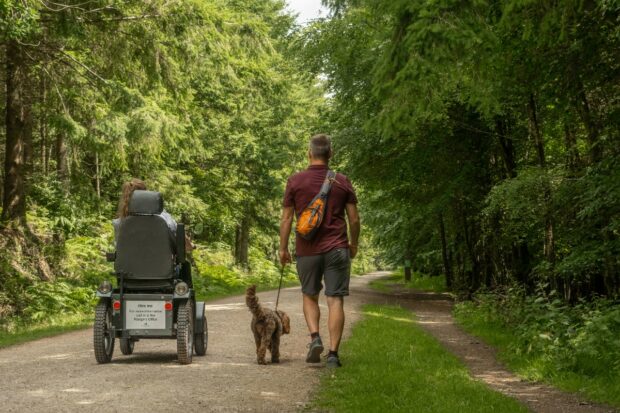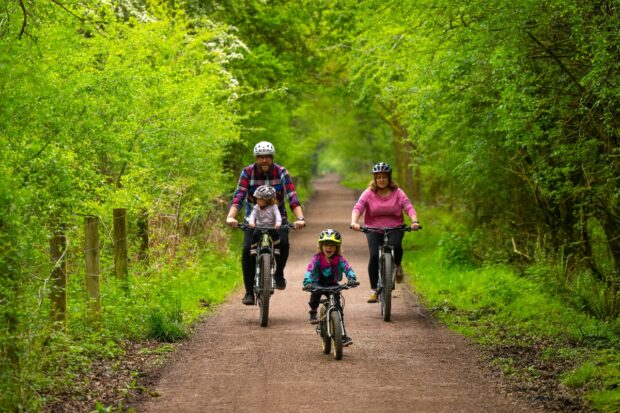 Alison Hallas, Woodland Access Advisor at the Forestry Commission, sets out why public access to woodlands is so important and some of the actions that the Forestry Commission and Defra are taking to make it easier for everyone to access them.
Alison Hallas, Woodland Access Advisor at the Forestry Commission, sets out why public access to woodlands is so important and some of the actions that the Forestry Commission and Defra are taking to make it easier for everyone to access them.
On 29 November, the government published its Woodland Access Implementation Plan which sets out new ambitions to improve the quality, quantity and permanency of public access to new and existing woodlands in England.
By implementing the Woodland Access Implementation Plan, we are working towards meeting one of the commitments of the Environmental Improvement Plan - that everyone should live within 15 minutes' walk of a green or blue space.

Why is access to woodlands so important?
Last year people made over 290 million visits to the nation's forests, managed by Forestry England. The most recent Public Opinion of Forestry survey also found that nearly 75% of people have visited woodlands in the last few years. These numbers show the extent of the public’s appreciation for woodlands and forests and highlights their growing role as sought-after destinations that promote wellbeing and recreation.
Forests and woodlands are good for our mental health. Woodland visits offer a refreshing escape from daily life, for exercise, relaxation, meditation and connection to nature. Almost 90% of people surveyed by the Forestry Commission last year agreed that woodlands provide spaces for relaxation and reducing stress.
Woods can maintain an immersive sense of spaciousness and natural charm even when hosting a considerable number of visitors. They change with each season, offering something new throughout the year, from blooming bluebells to vibrant autumn colours. They are popular with walkers, cyclists, and horse-riders but also offer other adventures that are unique to woodlands, such as high-ropes courses.
Having access to woodlands also enables people to better understand and appreciate the nature around them, and why we need to protect and nurture it, as well as showcasing the working environment that many of our woods are. It allows people to experience sustainable forestry management and better understand the value of home-grown timber and wood products.
What are the barriers to woodland access?
We know that not all communities enjoy the same opportunities to access woodlands and that there are differences in how confident people feel about visiting them. The increase in woodland visits during the pandemic put pressures on some woodlands and raised awareness of the importance of having easy access to our local green spaces.

We understand also that the quality of visitor experiences can vary. In areas with high demand, it is vital that we ensure woodlands can welcome visitors both safely and sustainably, protecting wildlife and delivering the many other benefits to society that they support, such as improved water quality and capturing and storing carbon emissions.
The Woodland Access Implementation Plan
Through the Woodland Access Implementation Plan, we are taking steps to improve the quantity, quality and permanency of public access to woodlands. Here are a few examples of the work that’s underway:
We are gathering evidence to find out more about where, how and why people visit woodlands, and the range of recreational activities that people go to woodlands to enjoy. This includes:
- Building a better picture of where the woodlands are that people can visit, which communities don’t yet have easy access to woods, and to understand how we can make it easier to find the woods people can visit.
- Gathering accurate information about how many people visit woodlands and what prevents some people from accessing them.
We are providing support to both landowners and visitors by:
- Researching the issues that land managers face when thinking about welcoming the public into their woods, to understand how we can provide more information and guidance.
- Looking for opportunities to let more people know what they can do when they visit woodlands, how they can tread lightly, keep safe and protect nature.
Through our grants for woodland creation and management, we are:
- Supporting the creation of many more new woodlands, providing an opportunity to create more, high quality places to enjoy for the future, in the right place, well-connected and close to people.
- Helping woodland managers who want to provide access to design their woods for people to enjoy.
Forestry England continue to break down barriers for visitors and welcome everyone into the nation’s forests. This includes:
- Creating new accessible woodlands such as the Coronation Woods
- Improving access for all through the Forests for Everyone programme
- Improving the range of infrastructure, such as investing in Pedal and Play trails for children learning their first mountain biking skills.

A lasting legacy
Over the coming months, we will be sharing updates and outputs from delivery of the Woodland Access Implementation Plan. We want to create a lasting legacy of accessible woodlands and forests. As they grow and develop, we want people to enjoy them, understand them, and cherish them.
You can read the Woodland Access Implementation Plan on GOV.UK.



1 comment
Comment by bob milton posted on
Your reports and surveys continue the bias against equestrian access. Equestrians are the only group of Non motorised users that the FC and FE make pay for access to woodland. In the last ten years FE SE region have extracted over £500,000. in permits from equestrians and have given nothing back other than to spend it on walking and cycling facilities.